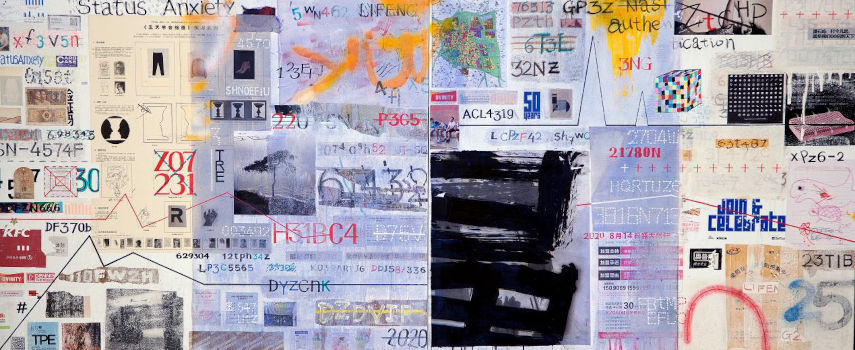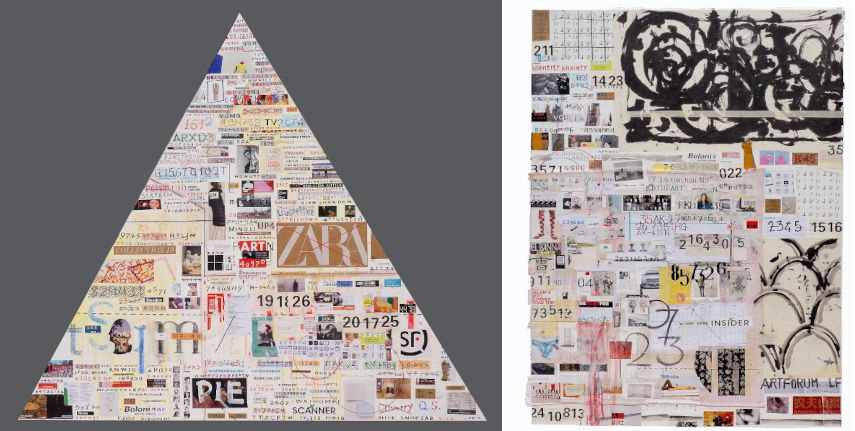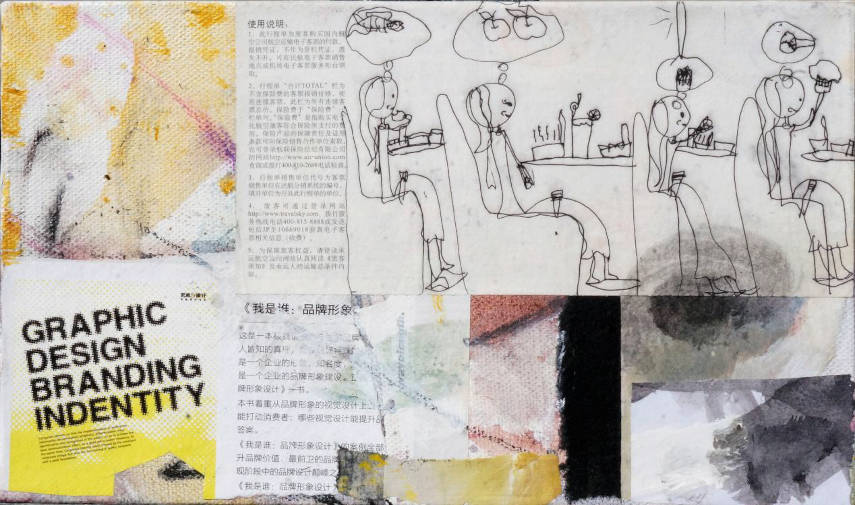Widewalls / Exploring the Remnants of a Digitized Subject – In Conversation with Li Feng / July 2023
For several years now, Chinese artist Li Feng has focused on the digital remnants of our age. Exploring the complex link between our present digital time and violence, Feng has decided to pick up what remains from this relationship in the form of signs and symbols and to turn them into an expression of our contemporary condition — both influenced by progress and restrictions that are sometimes very well hidden among the overbearing visual data.
The scale of his works is commensurate with content; digital symbols amass, creating a visual repository of contemporary anxieties exacerbated by the lack of direction and meaning, grasping at our perceptual field on large canvases.
Defying categorization, his practice builds on the academic forms of abstract art and introduces vernacular elements to expand his approach and develop new pictorial strategies.
Born in Jilin, China, Feng currently resides and works in Henan but has also established his presence in Los Angeles. The Shanghai Youth Art Exhibition winner, Feng has presented his work in numerous group and solo exhibitions and was selected for the National Exhibition of Fine Arts in China on several occasions.
We sat and talked with Li Feng about his intriguing visual expression, his recent series Possible Dilemmas, the philosophical underpinnings of his practice, and his future plans.

Exploring a Shared Cognitive Foundation
Widewalls: Throughout your practice, you explore different themes that comprise human experience, from everyday objects and symbols to language and emotions. What drew you to these topics, and what aspects of the contemporary condition do you find particularly productive for visual exploration?
Li Feng: In most cases, artists find it difficult to be bystanders in life. Different artists have different perspectives and angles when observing daily life, including applying techniques and modes of expression in artistic practice. Different emotions are presented through corresponding languages. Yes, in artistic practice, I only focus on my own emotions and thoughts.
The world is already fascinating—there is no particular aspect that is especially suitable for visual exploration. The world seems like a large supermarket, and everything has the potential to be chosen and practiced by artists in a broader and more expansive realm of thoughts, ultimately constructing a unique and personally captivating expression.
Widewalls: The human presence is almost entirely removed from your work, although the products of human labour are visible and very much present. You also explore spiritual facets of our existence. How do these different strands come together in your art?
LF: Yes, I did encounter the dilemma you mentioned while creating the series of works titled Possible Dilemmas (2008-2014). However, the CAPTCHAs and numerous numerical codes I utilized are all products of human labor (they are things familiar and used by humans in the present era). Clearly, they form a shared cognitive foundation between me as the artist and the viewers. In the specific process of creation, I currently lean towards a two-dimensional expression while also considering the painting attributes of the artwork. I believe that all forms of art are an adventure in their creation.
Note: CAPTCHA is the abbreviation of “Completely Automated Public Turing test to tell Computers and Humans Apart,” a type of challenge-response test used in computing to determine whether the user is human.

Visualizing Digital Remnants
Widewalls: In one of your recent series, Possible Dilemmas, you examine different codes we encounter daily using collage and mixed media techniques. How did the idea for the series emerge, and can you tell us more about the link between the codes and the artistic methods you chose?
LF: For our generation, as we embrace the arrival of new cultural attributes, such as computers and the Internet, in our lives and work, there is not just excitement but also a lot of contemplation and confusion about the future culture. Initially, there may be some anxiety and discomfort. Today, we are familiar with these things as we transition from the era of 4G to 5G, collectively working towards the globalized digital dream. This can make us nostalgic for the systemic violence of various institutions (economic, cultural, psychological, informational, discursive, etc.) that instrumentalize people and things.
Furthermore, this systemic violence in life is an irredeemable form of violence. We can draw on Slavoj Žižek’s (a Slovenian philosopher) reflections on violence to understand this phenomenon. There is a clear agent of subjective violence, such as a murderer killing someone, a capitalist exploiting people, or a nation launching an aggressive war. This kind of violence has a discernible source, and people know who has harmed whom. Subjective violence is relatively easier to deal with as it can be avoided or retaliated against. However, there is a more profound form of violence, which Žižek refers to as objective violence. People do not know who perpetrates this violence; it is anonymous and lacks a responsible subject. It is ubiquitous systemic violence.
During a period of tremendous transformation from the “modern” to the “global era,” this change entails a comprehensive control of life by technology, a control that can be anticipated. However, this control is in the form of comprehensive service rather than traditional authoritarian rule. Clearly, the Internet of Things, artificial intelligence, smart cities, commercialized media, and so on will provide universal and equal comprehensive services. Yet, each individual may become inexorably dependent on this excellent service, much like a drug addict, and willingly accept being controlled.
The all-encompassing service seems to offer abundant freedom of choice and full equality, but at the same time, it manipulates every aspect of people’s lives and thoughts. This is a new form of totalitarianism: everyone appears to be free, yet the entire realm of options and power is defined and pre-determined by information and services. This freedom lacks creativity; it only offers choices. Consequently, the meaning of life disappears—this is what truly causes anxiety!
It is an anxiety about the meaning of life caused by technological progress under the conditions of globalization. Exactly, what I want to say is that within the vast ocean of network practices driven by various desires, the individual forms of each consumer have already been digitized. Perhaps we can go back and forth with a few clearer CAPTCHAs to ensure accurate input, but this hurdle is something we cannot avoid.
This is probably the essence of my profound “digital perplexity” In my artistic creation, I primarily express the “identity remnants” of this “digitized subject” – the truth of the flesh, spirit, and identity within the digital realm. To be more self-aware, our subjectivity is nothing more than “leeks” (a metaphor for being easily exploited), and I attempt to convey not abstract art but the fragmented identities of individuals in the context of digital management.

Showcasing Numerous Forms of Information
Widewalls: Technological progress, social media, and globalization have created a lot of anxiety in contemporary societies. Exerting control over all aspects of human existence has been particularly pronounced. How do you approach these tensions in Possible Dilemmas?
LF: As an ongoing experimental project, this series of works is still in the process of exploration and refinement. I am trying to create a strong impact on the information age, with a dense array of signifiers and codes filling the images. Due to the need to showcase numerous forms of information within limited space while ensuring clarity, I have condensed large physical storefronts into tiny logos. This represents the ultimate application of media communication in the context of “urban-commerce-billboard-flat map-consumer expectations.”
The form of the information battlefield on the artwork involves various small and large “digital” elements negated by red lines or crosses, indicating their inability to enter or proceed to the next stage. In the realm of desire-driven online practices, one must confront and overcome the warning sign of identity verification – a CAPTCHA!
Widewalls: The works are large in scale, with the longest side often going over 1 meter. Why did you decide on this format, and what large scale brings to the series?
LF: A two-dimensional artwork, its content expression, and its dimensions possess a natural and mysterious connection as if everything has already been predetermined and humans can only discover it. The ancient Greeks conducted extensive research on the rules of form, with the golden ratio being the most fundamental rule, where the ratio of all objects in the world is considered most beautiful at 5:8. Greek sculptures and architecture were designed according to this ratio.
Therefore, I believe many outstanding artists have a profound recognition of this concept – there is always a perfect relationship between the size of dimensions and the expression of content. It is akin to writing a poem or publishing a poetry collection, where the grasp of proportion must be intuitive and foresighted. In fact, I even privately believe that a poetry collection with a spine thickness exceeding one centimeter is unethical.

Continuous Experimentation
Widewalls: You are on a constant quest for new pictorial strategies, changing your style and approach over the decades. Could you tell us a bit about your artistic development and your practice so far?
LF: From 2014 until now, I have been engaged in creating a pure painting series named B movie, and I have never interrupted this pursuit. Clearly, it suits me better. Some of the thoughts that emerged from this journey have prompted me to explore new possibilities and approaches, often starting from a single point.
Continuous experimentation mostly takes place amidst a mix of nervousness and unexpected surprises, but setbacks and feelings of frustration are never far behind, as evident in the series we are discussing at present.
Widewalls: You currently reside in Henan, China. How much do this place and Chinese artistic discourses, in general, inspire and influence your practice?
LF: In 2021, I established my own studio in Shanghai, and in 2022, I collaborated with others to establish another studio in Los Angeles. We named it “Island.” Most of the time, I choose to be with my wife (who works in Henan), so there is also a space for me to create there.
Generally, I pay more attention to the inner life experiences and often reflect what I see in front of me based on my own inner experiences. In this regard, my artistic practice is not limited by the influence of a specific regional culture (although it is something I need to be vigilant about).
Artistic practice is ultimately an independent and unique attribute, expressing the connections and communication between myself and the world through the language, images, and objects of both visual and art history.

Unforgettable Moments and Future Plans
Widewalls: You have participated in numerous solo and group shows in China and abroad. Can you highlight some of them for us, including the works you presented? What was your most challenging show so far?
LF: Yes, there are many stories in this regard. Some things (the incidents that happened) are still unforgettable, both in terms of positive aspects and unpleasant experiences.
In 2017, I participated in the “Chinese Spirit – The 4th China Oil Painting Exhibition (Section 3) – Abstract: Contemporary Chinese Non-figurative Oil Painting Art Exhibition” at the Today Art Museum in Beijing. My selected work “Ordinary Scene” was a piece that I was satisfied with. This exhibition, in my impression, was the first official academic exhibition of abstract paintings in China, and it had a significant impact on society. The selected artworks were of high artistic quality.
Additionally, the “John Moore Painting Prize (China) Exhibition” showcased the diversity, openness, and fairness of artistic perspectives, presenting the latest trends in contemporary Chinese painting. I was also delighted to have been selected for this exhibition twice. However, this has been one of the challenges I have faced so far: If I could win an award in the exhibition, you know, I would be able to go to the UK for a residency and hold an exhibition there!
Widewalls: What are your plans for the rest of the year? Where can we expect to see your work next?
LF: I will participate in several planned exhibitions, including a solo exhibition at Nowhere Gallery in Zhengzhou, China, and a group exhibition at another gallery. I also have some works to start in my studio in Shanghai. Up until now, my works have mainly been published on my personal website and Instagram. In China, people are more active on platforms like WeChat and Xiaohongshu (an app called Little Red Book).
